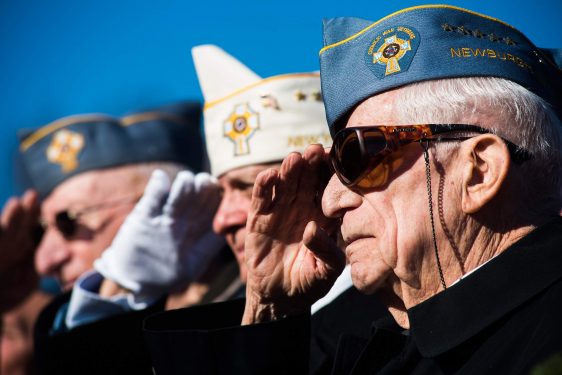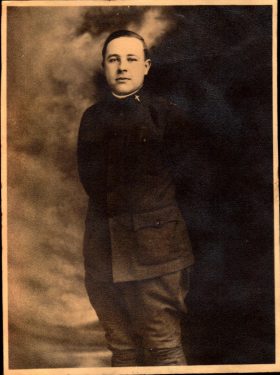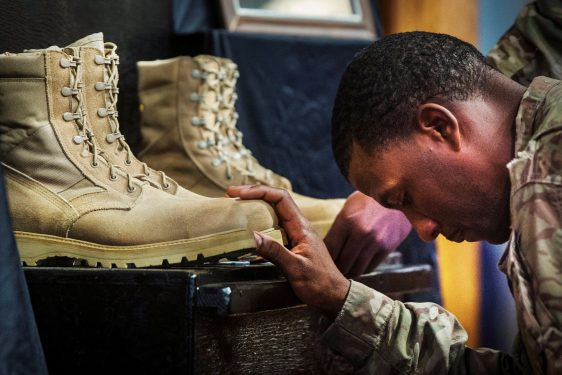
ASTORIA — The Catholic War Veterans & Auxiliary of the United States needs reinforcements to help fellow vets who stepped up when their country called.
In the past three years, the CWV has arranged funerals throughout New York City for 86 indigent vets.
“Only two of them we knew were Catholic,” said Dave Crum of Astoria, the group’s national commander.
Since 1935, CWV and its auxiliary have helped former servicemembers with numerous problems, such as untangling bureaucratic barriers while dealing with the U.S. Department of Veterans Affairs.
But while members of the CWV must be practicing Catholics, the people they serve can be from any denomination — or none at all.
“We serve any veteran,” said Crum, who was a Coast Guard yeoman in the 1960s. “You could be an atheist, but you’re a veteran. And if you need help securing your VA benefits, we have a veteran service office that can assist you.”
Most of CWV’s workload gets handled by die-hard Vietnam-era vets like Crum and John O’Shea of Levittown, CWV’s state commander for New York.
Together they’ve embarked on a comprehensive effort to recruit younger members who can carry on CWV’s work, like addressing the growing numbers of veterans facing homelessness or contemplating suicide.
“All veteran service organizations are scrambling to recruit younger members,” said O’Shea, who saw combat with the Army’s 25th Infantry Division in Vietnam. “I’m in my 70s. A lot of people are in their 70s. That’s why I’m desperately trying to reach a younger generation because we do some very good work for both the church and our veterans.”
For God, for Country, for Home
The first CWV post began in the Diocese of Brooklyn. In 1935 Msgr. Edward J. Higgins, a chaplain in World War I, envisioned a service organization to help former warfighters while affirming the Catholic faith.

Msgr. Higgins recruited veterans at his parish, Immaculate Conception Church in Astoria, to create Post #1 of the Catholic War Veterans & Auxiliary of the United States.
Its motto: “For God, for country, for home.”
By 1945, New York City and the rest of the nation were awash with veterans returning home from World War II. CWV responded by volunteering at VA hospitals, sending care packages to troops still deployed, and, in recent years, helping homeless vets find services.
They’ve also sponsored youth programs, scholarships, art contests, and holiday toy drives.
The CWV is now a national service organization with several thousand members in posts all over the U.S.
‘What Can We Do?’
Dealing with homelessness and suicide are the top concerns of CWV’s members.
In January, the U.S. Department of Housing and Urban Development reported to Congress that a single-day sampling in 2020 showed 37,252 homeless veterans — about 8 percent of all homeless adults.
“Of every 10,000 veterans in the United States, 21 were experiencing homelessness,” the report stated.
Meanwhile, the VA’s latest data shows that about 18 veterans die by suicide each day. However, some observers suggest there could be more because first responders do not always learn if a suicide victim served in the military.
“My heart goes out,” O’Shea said. “What would cause a man, or a woman — who went through all this training and survived combat — to want to take their own lives? What can we do? I don’t think we’re doing enough.”
“Just last year, a guy took his life right in the parking lot of a VA (facility); shot himself in the head,” he added. “But he was so close to help. But what can you do? In that case, we couldn’t do nothing.”
Said Crum: “We want to reach out to those individuals and see if we can provide services to them on a national basis.”
“But,” he added, “the family comes along with the veteran. So if the veteran is in need, so is that family.”
‘We Need Young Blood’
While the need to provide services for veterans is growing, demographics suggest that CWV’s numbers could be dwindling more rapidly in the next decade.
CWV member Paul D’Elia of Williamsburg, Brooklyn, is a former commander for Post #689. He estimated that about 10 World War II-era vets belonged to the post in recent years, but now only a few remain.
Meanwhile, membership overall is down. D’Elia says it’s because there is a much smaller pool of vets to recruit.
According to U.S. Department of Defense estimates, only 1 percent of the U.S. population is serving or has served in the military. An estimated 25 percent of them are Catholic, according to the Archdiocese for the Military Services.
“I always tell the younger guys, ‘we need young blood,’” D’Elia said, “because we’d like to keep it going longer.”
D’Elia, an Army helicopter door-gunner in Vietnam, said modern vets and active-duty troops often find themselves “in a dark place.” The reason is how the military manages recent deployments, he said.
He explained that because there is no conscription (or draft) of the larger population, the nation has relied on its 1 percent all-volunteer military to fight conflicts. Consequently, many troops serve multiple deployments, which takes a toll on them and their families.
“They send the same guys over and over,” D’Elia said. “That kind of stress in combat can really break a person.”
Therefore, the need to help them will remain constant, D’Elia said.
“We need young blood to get things done,” he added. “I’m 74 now, and I wish I still had more energy to set up tables and do whatever else.
“It would be nice to have guys ages 40 to 50, or some around 30 would be even better.”
Gonzalo Murillo, who belongs to Blessed Sacrament Parish in Jackson Heights, Queens, said he passed Post #1 while in traffic. He saw the sign but just assumed it was a club where vets went to “trade war stories.”
Murillo, 44, a veteran, said he didn’t know about the services offered by CWV and its auxiliary. But, the need, he agreed, is great.
“I was talking to my cousin about this just last night,” Murillo said. “He was in the Marines, and I’m Navy and Army, and he was saying how, as soon as you leave the service, you don’t know what to do. A lot of people say, ‘I don’t have anyone to talk to about this.’
“For some of these guys, suicide is an easy way out, but it’s not.”
Murillo said he’d like to know about the group. He’s already pretty busy with his career and family. He was also one of the organizers of his parish’s weekly food ministry during the pandemic.
‘Not Restricted to the Veteran’
The latest CWV membership drive kicked off with a letter-writing campaign to Catholic bishops and deaneries, asking them to share recruitment materials with their pastors.
Crum said it takes 14 vets and a chaplain, usually a parish priest, to form a new CWV post. According to Crum, veterans must have served at least 90 days of active duty, whether starting a post or joining an existing one.
“There is no wartime requirement for joining up,” Crum noted. “Any National Guard member or Reserve member that has 90 days active duty can join. A senior from any service academy can join because they have 90 days of active duty.”
Also, servicemembers can join while still on active duty, including personnel from the Army, Air Force, Marine Corps, Navy, and the newly-formed U.S. Space Force.
But people who never served in the military can also help by becoming members of the CWV’s auxiliary. They, too, must be Catholic and have at least one relative who served, Crum said.
“We need more veterans,” Crum said. “But if you really think about it, the auxiliary should be five times the size of the veterans because it is not just not restricted to the veteran.”
O’Shea said he is pleased with responses from New York state bishops. He subsequently signed up some new members, mostly from upstate and a Levittown vet who served in Afghanistan.
Bishop Nicholas DiMarzio, Diocese of Brooklyn, also responded to the campaign.
“When we talk about Catholic War Veterans,” he said, “this is an organization started as Catholics remembering their experiences as veterans and supporting one another. So it was basically a mutual-support society that they put together.”
“Some of them, because of trauma, do have special needs, but what they look for is respect,” the bishop added. “Everybody wants respect. They’re very sensitive to their commitment to the past. And they want to be acknowledged now for what they did.
“I think veterans are people that put themselves out there to defend our country. So they deserve our respect and honor, and they should be taken care of.”
CWV National Convention Aug. 3-7
The next national convention Catholic War Veterans & Auxiliary of the United States is set for Aug. 3-7 in Queens. For information about the convention, for joining, or starting a post, call 703-549-3622, or visit wp1.cwv.org.

